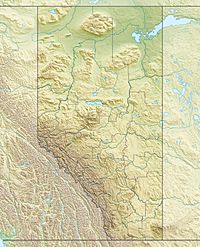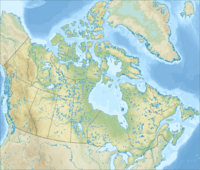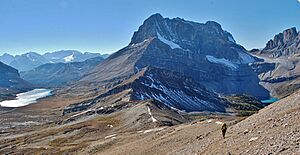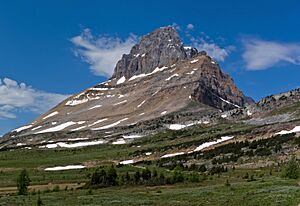Ptarmigan Peak (Alberta) facts for kids
Quick facts for kids Ptarmigan Peak |
|
|---|---|
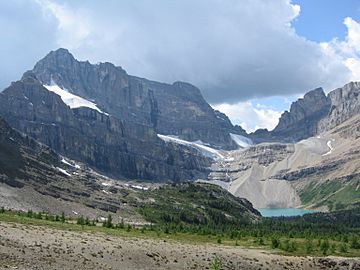
Ptarmigan Peak (left) seen from Deception Pass
|
|
| Highest point | |
| Elevation | 3,059 m (10,036 ft) |
| Prominence | 209 m (686 ft) |
| Listing | Mountains of Alberta |
| Geography | |
| Parent range | Slate Range Canadian Rockies |
| Topo map | NTS 82N/08 |
| Climbing | |
| First ascent | 1909 |
| Easiest route | Moderate scramble |
Ptarmigan Peak is a tall peak located in Banff National Park, Alberta, Canada. It stands right next to Pika Peak. This beautiful mountain is part of the Canadian Rockies, a huge mountain range in North America.
The mountain got its name in 1909. A person named J.W.A. Hickson named it after he saw many ptarmigan birds. These birds were in the grassy areas below the peak. Hickson also made the first climb to the top of Ptarmigan Peak. He was guided by Edward Feuz Jr.
Ptarmigan Peak is close to the Lake Louise Mountain Resort. This popular ski area is on the southern side of Merlin Ridge. Other peaks like Mount Richardson and Pika Peak are also part of this ridge. There's a special campground for hikers near the mountain. It is located close to Hidden Lake.
Climbing Ptarmigan Peak
Climbing Ptarmigan Peak is a fun adventure. The easiest way to reach the top is by a route called a "scramble." Scrambling means you hike up steep, rocky terrain. You might need to use your hands for balance. This route starts from Hidden Lake and goes up the southern side of the mountain.
How Mountains Are Made: Geology
Like other mountains in Banff Park, Ptarmigan Peak is made of sedimentary rock. This type of rock forms from layers of sand, mud, and tiny bits of sea creatures. These layers built up over millions of years. This happened during the Precambrian to Jurassic periods. Back then, the area was covered by shallow seas.
Later, a huge event called the Laramide orogeny happened. This was a time when the Earth's plates moved and crashed together. This powerful force pushed the sedimentary rock layers upwards. They were folded and broken, forming the tall mountains we see today.
Weather at Ptarmigan Peak
Ptarmigan Peak has a subarctic climate. This means it has very cold and snowy winters. The summers are usually mild. Temperatures can drop below -20 °C (which is -4 °F). With the wind, it can feel even colder, sometimes below -30 °C (-22 °F). It's important to be prepared for cold weather when visiting.


